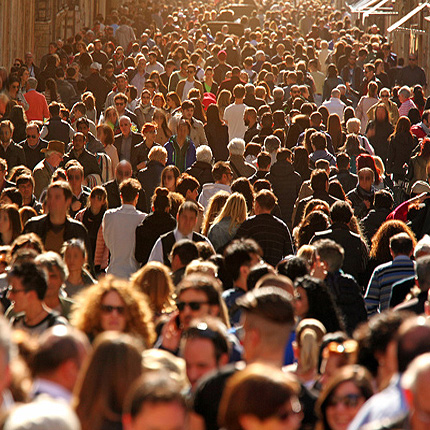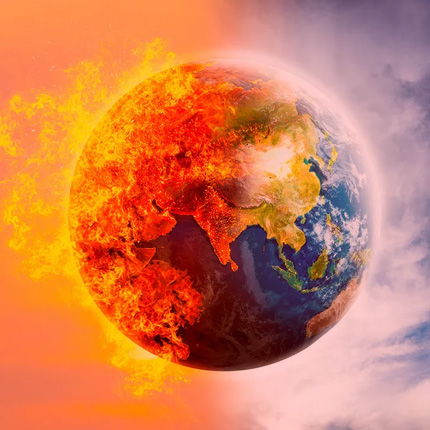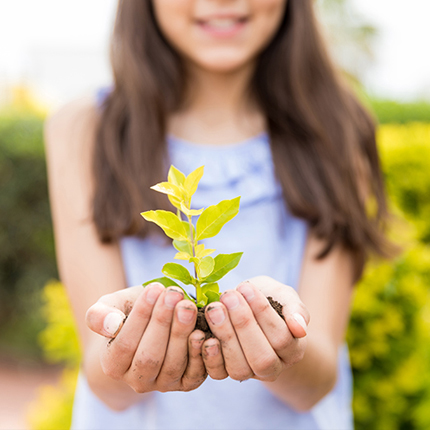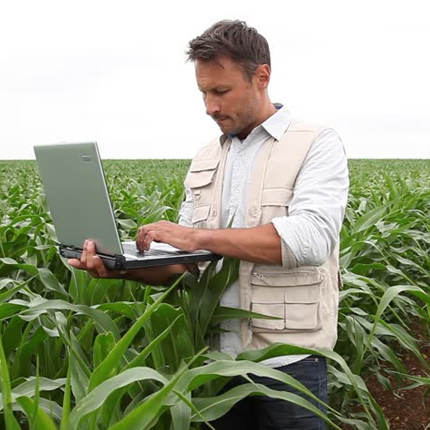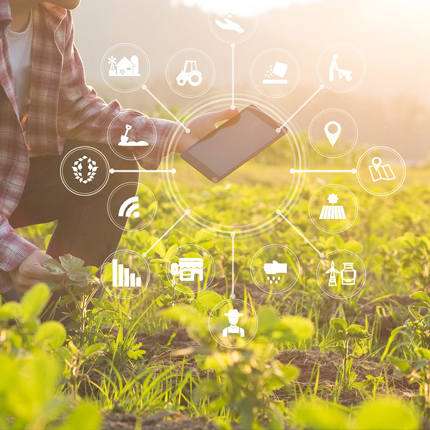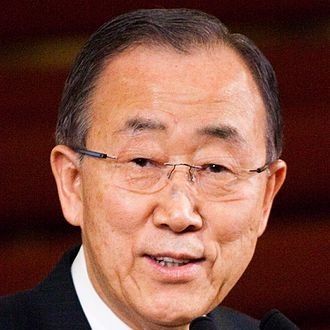Feeding a Growing Population in the Face of Environmental Challenges
The world's population is expected to reach 10 billion people by 2050, requiring 56% more food than what's available today. Meeting future demands will require developing a sustainable way forward for food production and consumption.
Our exploding global population is creating a significant squeeze. We must produce more food to feed everyone and protect the environment, including its rich biodiversity. Since the 1950s, the world's population has more than doubled. With limited land available, we urgently need to find ways to shrink the footprint of food production per person.
Humans have dramatically transformed the planet for agriculture.
Over the past millennium, we've converted a tiny fraction of usable land (less than 4%) into vast swaths of farmland, using nearly half (44%) of all habitable land today (an area five times the size of the US).
Livestock dominates land use. While only 16% of farmland grows food directly for humans, 80% is dedicated to raising animals for meat and dairy. However, livestock provides a small portion of our overall calories and protein (17% and 38%).
Data source: Food and Agriculture Organization of the United Nations (2023); Food and Agriculture Organization of the United Nations (2024).
Global Demand and Environmental Impact
With the world's population expected to reach 9.8 billion by 2050, there is a considerable surge in the need for food, especially animal-based protein, projected to increase by nearly 70%. Existing agricultural practices take a toll on our environment, utilizing 40% of the Earth's land and 70% of freshwater. These intensive methods lead to land degradation, water scarcity, and biodiversity loss.
Paris Agreement and Environmental Sustainability
In line with the pressing need to address the environmental impact of global food production, the Paris Agreement of 2015 set an ambitious target to combat climate change. The agreement involves 195 nations pledging to keep global warming "well below" 2°C by the century's end and striving to cap it at 1.5°C. This aligns with the critical goal of balancing food production for a growing population while mitigating environmental harm.
Food Systems: A Threat to Our Planet's Health?
The food, agriculture, and land use sectors directly contribute approximately ~22% of the world's greenhouse gas emissions (IPCC), nearly comparable to the emissions from electricity or industry. When factoring in indirect emissions such as methane from food waste in landfills or food processing, the total contribution reaches about ~34% (EDGAR-FOOD), ‘one-third’ of human-caused emissions, which continue to rise. The environmental impacts extend beyond climate change, significantly affecting water, land, and biodiversity, underscoring the urgent need for comprehensive solutions to address these complex issues.
Seafood as a Sustainable Food Source
Once considered an endless bounty, seafood has been essential for meeting the dietary needs of a growing population. The world produces around 200 million tonnes of fish and seafood annually from wild fish catch and farming. However, overfishing and the depletion of fish stocks have raised serious concerns about the sustainability of wild fisheries.
Aquaculture: A Potential Solution to Overfishing
Overfishing has severely impacted (declined) wild fish stocks, necessitating reduced fishing efforts for recovery. Decades of overfishing have tripled the number of overfished stocks since 1970, according to the UN Food and Agriculture Organization. In 2024, it is estimated that over 37% of these fish stocks were overfished.
Aquaculture and Sustainability Challenges
Aquaculture is an essential solution to meet the growing demand for seafood. We cannot take endless numbers of wild fish from our oceans, so if we want more fish, we must produce our own. The rapid growth of aquaculture over the last few decades has been remarkable, with farmed fish production now exceeding that of wild fisheries. By 2050, global fish consumption will increase by nearly 70%. Aquaculture can bridge this gap and reduce pressure on wild fish populations. This increasing shift is vital for meeting future food needs as the population grows and seafood consumption rises.
However, challenges remain in scaling up aquaculture sustainably. Similar to any animal farming, aquaculture requires feeding the fish. A key challenge lies in addressing the reliance on ingredients sourced from industrialized agriculture, which often involves practices with negative environmental impacts like deforestation or water pollution. Additionally, rapidly scaling up aquaculture within limited ecological constraints, such as access to land and freshwater, presents a significant hurdle.
Other Sustainability Concerns
- Industrialized Feed: Another concern about the rise of aquaculture is its impact on wild fish stocks. Many farmed fish, especially carnivorous species, are fed fishmeal and fish oils derived from wild fish. While not all aquaculture species are fed from animal sources, fish farmers often use fishmeal and oils because they provide an almost perfect balance of essential nutrients such as omega-3 fatty acids. However, this practice increases pressure on wild fish populations, creating sustainability challenges.
- Environmental Impact: Without ecological guidance, intensive aquaculture can mimic industrialized agriculture, raising concerns about pollution, water use, and habitat destruction from direct sources (eutrophication, ocean acidification, dead zones) and indirect sources (e.g., chemicals, pesticide run-offs, or deforestation from industrial agriculture feeding ingredients). These factors contribute to climate change, biodiversity loss, and increased CO2 emissions.
- Resource Constraints: Scaling up quickly while respecting environmental limitations is a challenge. Both land and freshwater resources are finite.
The Feed Dilemma: Fishmeal, Plant-based Ingredients, and Sustainability
Traditionally, aquaculture relied heavily on fishmeal and fish oil for fish feed, particularly for carnivorous species. This practice strains wild fish populations, creating a catch-22 situation. Shifting to plant-based protein and ingredients such as soy, corn, wheat, or palm oil in fish feed formulas has increased and reduced reliance on fishmeal and fish oil. However, this creates another challenge:
Industrialized Agriculture and Sustainability Challenges
While plant-based ingredients and protein for fish feed offer a promising alternative to reducing fishmeal, large-scale production often relies on industrialized agriculture practices that can contribute to deforestation, land degradation, and water scarcity.
These questions highlight the complex web of challenges. We need to increase food production, particularly animal protein, but current agricultural practices are unsustainable. While aquaculture offers a potential solution for seafood, its reliance on practices linked to unsustainable agriculture creates a cycle that could further exacerbate environmental damage.
On land, there is a constant struggle between conservation and food production
There are roughly 130 million km2 of ice-free land on this planet. One-third of this land is currently used for agriculture (~12% and ~22% are devoted to croplands and grazing, respectively). We have converted or modified ~20% of Earth’s forests and ~50% of its savannas, grasslands, and shrublands for farming. The pressure to convert land is unrelenting; the expected growth of the world’s human population, combined with shifts in the diet as people become wealthier, may require a doubling of global food production by 2050.
Roughly another 25 million km2 (~20%) of land is estimated to be suitable for farming. While this is a lot of land, most lies beneath tropical rainforests with high ecosystem service value. Thus, agriculture has been and will continue to be the primary cause of habitat and biodiversity loss.
Decoupling Aquaculture and Industrial Agriculture
The intertwined nature of food production, environmental sustainability, and resource use presents challenges that require strategic management and innovative solutions. To ensure a sustainable approach to food production for a growing population, the interplay between aquaculture, industrialized agriculture, and environmental impacts must be carefully addressed. Finding solutions that decouple these systems while maintaining food security without exceeding environmental limits is crucial for long-term sustainability.

